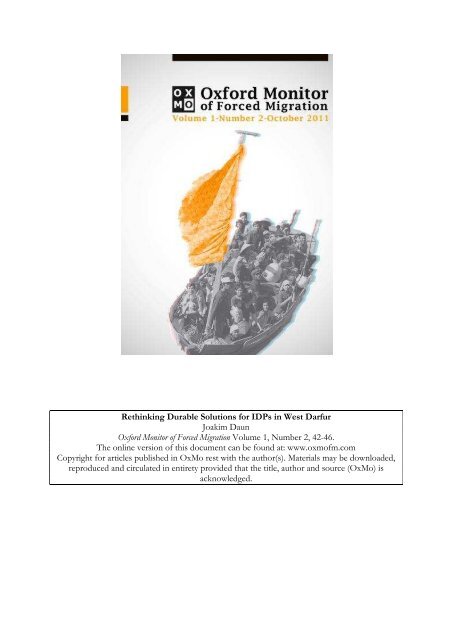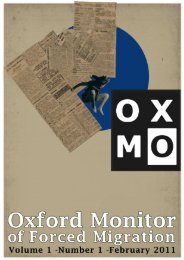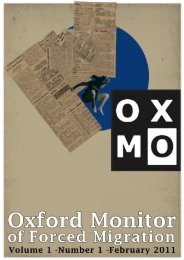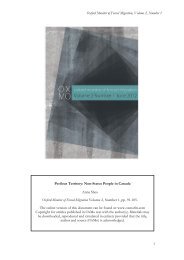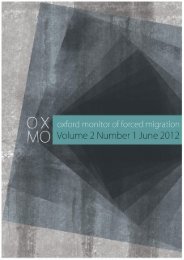Rethinking Durable Solutions for IDPs in West Darfur Joakim Daun ...
Rethinking Durable Solutions for IDPs in West Darfur Joakim Daun ...
Rethinking Durable Solutions for IDPs in West Darfur Joakim Daun ...
You also want an ePaper? Increase the reach of your titles
YUMPU automatically turns print PDFs into web optimized ePapers that Google loves.
<strong>Reth<strong>in</strong>k<strong>in</strong>g</strong> <strong>Durable</strong> <strong>Solutions</strong> <strong>for</strong> <strong>IDPs</strong> <strong>in</strong> <strong>West</strong> <strong>Darfur</strong><strong>Joakim</strong> <strong>Daun</strong>Ox<strong>for</strong>d Monitor of Forced Migration Volume 1, Number 2, 42-46.The onl<strong>in</strong>e version of this document can be found at: www.oxmofm.comCopyright <strong>for</strong> articles published <strong>in</strong> OxMo rest with the author(s). Materials may be downloaded,reproduced and circulated <strong>in</strong> entirety provided that the title, author and source (OxMo) isacknowledged.
<strong>Reth<strong>in</strong>k<strong>in</strong>g</strong> <strong>Durable</strong> <strong>Solutions</strong> <strong>for</strong> <strong>IDPs</strong> <strong>in</strong> <strong>West</strong> <strong>Darfur</strong>By <strong>Joakim</strong> <strong>Daun</strong>As a result of the conflict <strong>in</strong> <strong>Darfur</strong> some 200,000 people were killed and some 1.9 to 2.7 millionfled their villages and settled <strong>in</strong> IDP camps <strong>in</strong> the three <strong>Darfur</strong> States (OCHA 2009 and IDMC2010). 31 Most of the displacement took place <strong>in</strong> 2003 and 2004, but small scale displacementstook place after that and cont<strong>in</strong>ue to take place (OCHA 2009 and Human Rights Watch 2011).Eight years later, <strong>in</strong> 2011, many <strong>IDPs</strong> have not yet found a durable solution 32 and the <strong>Darfur</strong> <strong>IDPs</strong>ituation should be considered protracted. The Government of Sudan (GoS) cont<strong>in</strong>ues topromote return as the durable solution <strong>for</strong> the <strong>IDPs</strong> <strong>in</strong> <strong>Darfur</strong>. While some <strong>IDPs</strong> mightvoluntarily return, the majority of them are likely to stay <strong>in</strong> urban areas due to the larger trend ofurbanisation. There<strong>for</strong>e, the ma<strong>in</strong> approach to durable solutions <strong>for</strong> the <strong>Darfur</strong> <strong>IDPs</strong> should bereconsidered by the GoS and the <strong>in</strong>ternational community with an emphasis on local <strong>in</strong>tegrationand susta<strong>in</strong>able <strong>in</strong>terventions.Despite evidence that most <strong>IDPs</strong> are unlikely to return, GoS has cont<strong>in</strong>ued to view return as thepreferred durable solution. 33 In 2005, UNHCR and GoS signed a letter of understand<strong>in</strong>g thatUNHCR would monitor the right of return to areas of orig<strong>in</strong>. 34 As of 2010 it was clear that therehad not been any larger number of IDP return <strong>in</strong> <strong>West</strong> <strong>Darfur</strong>. Although some <strong>IDPs</strong> startedreturn<strong>in</strong>g <strong>in</strong> 2010, the majority have not opted to return.Return has been promoted ma<strong>in</strong>ly <strong>in</strong> the <strong>for</strong>m of ‘model villages’ (also known as ‘cluster villages’)where schools, hous<strong>in</strong>g, police stations and the like have been constructed. These types of ef<strong>for</strong>tshave largely been unsuccessful <strong>for</strong> various reasons. The return has often been <strong>in</strong>duced by GoS,ma<strong>in</strong>ly at the local level, and there is rarely any long-term susta<strong>in</strong>able support that can allow the<strong>IDPs</strong> to settle <strong>in</strong> the area. In addition, the villages have often not been constructed <strong>in</strong> the placeswhere the <strong>IDPs</strong> orig<strong>in</strong>ated from, and they are often not properly consulted. Consequently, themajority of the villages rema<strong>in</strong> un<strong>in</strong>habited. Further, f<strong>in</strong>d<strong>in</strong>gs suggest the population movementshave been seasonal, rather than permanent, with the vast majority of <strong>IDPs</strong> leav<strong>in</strong>g the camps toengage <strong>in</strong> cultivation as a complementary livelihood strategy and return<strong>in</strong>g immediately to areasof displacement follow<strong>in</strong>g the harvest (UNHCR 2010).Multiple factors contribute to return as a less than ideal durable solution. There are not onlyphysical obstacles to return such as <strong>in</strong>security, access to land and availability of livelihoods, butalso less tangible factors that must be taken <strong>in</strong>to account, such as social or ethnic identity andaccess to humanitarian assistance and services. First of all, as of end of 2010, many areas of <strong>West</strong>31 Some 250,000 <strong>Darfur</strong>ians also crossed the border to Chad as refugees.32 The UN Inter-Agency Stand<strong>in</strong>g Committee (IASC) has <strong>in</strong> its Framework on durable solutions <strong>for</strong> <strong>in</strong>ternallydisplaced persons (2010) def<strong>in</strong>ed durable solutions <strong>for</strong> <strong>IDPs</strong> as: 1) Susta<strong>in</strong>able re<strong>in</strong>tegration at the place of orig<strong>in</strong>(referred to as “return”); 2) Susta<strong>in</strong>able local <strong>in</strong>tegration <strong>in</strong> areas where <strong>in</strong>ternally displaced persons take refuge(local <strong>in</strong>tegration); and 3) Susta<strong>in</strong>able <strong>in</strong>tegration <strong>in</strong> another part of the country (settlement elsewhere <strong>in</strong> thecountry).33 In August 2010, GoS launched its new policy called <strong>Darfur</strong>: Towards A New Strategy to AchieveComprehensive Peace, Security and Development. The policy declared that ‘voluntary, safe and systematicreturn of the <strong>IDPs</strong> to their home will be the last<strong>in</strong>g <strong>in</strong>dicator of the successful solution of the conflict’, and ‘theorganization of the return is one of the government top priorities.’ The policy also prioritises provid<strong>in</strong>gassurances and <strong>in</strong>centives <strong>for</strong> <strong>IDPs</strong> to return to their homes as well as development support to people <strong>in</strong> theirareas of orig<strong>in</strong>.34 Accord<strong>in</strong>g to the agreement UNHCR shall monitor the voluntary character of any return and that it takes place<strong>in</strong> conditions of safety and dignity, as well as humanitarian access to IDP and returnee populations.
Vol. 1 - No. 2 - 2011<strong>Darfur</strong> still rema<strong>in</strong>ed non-conducive to return due to general <strong>in</strong>security and lack of law andorder, particularly banditry, crop destruction, and loot<strong>in</strong>g (UNHCR 2011). 35 In particular, womenface harassment and violence ma<strong>in</strong>ly when return<strong>in</strong>g to cultivate (UNHCR 2010).Second, the ability <strong>for</strong> <strong>IDPs</strong> to access land <strong>in</strong> their villages of orig<strong>in</strong>, and the possibility <strong>for</strong> <strong>IDPs</strong>to re-assert traditional land rights are crucial to allow <strong>for</strong> permanent return to take place(Pantuliano 2007). Further complicat<strong>in</strong>g the issue is the fact that pastoralist/nomadiccommunities are chang<strong>in</strong>g their lifestyles and have started to permanently settle <strong>in</strong> areas where<strong>IDPs</strong> assert land rights (UNHCR 2009). 36 The native adm<strong>in</strong>istration is currently too weak toaddress the situation and defend the land tenure rights of <strong>IDPs</strong>. Although there are localadm<strong>in</strong>istrative structures such as Peace and Reconciliation Committees <strong>in</strong> some places, they oftenreflect significant power imbalances between sedentary and newly-settled semi-nomadic andpastoralist communities. If these committees are not significantly strengthened, return will not bea viable option <strong>for</strong> most <strong>IDPs</strong>. These issues rema<strong>in</strong> politically sensitive, complex, andcompounded by different understand<strong>in</strong>gs of the native adm<strong>in</strong>istration and its relationship to thestate and by a lack of legal documentation (Tajeld<strong>in</strong> 2010).Third, livelihoods and food security are a major factor affect<strong>in</strong>g returns. Decreas<strong>in</strong>g food rations<strong>in</strong> the IDP camps have led to larger numbers of <strong>IDPs</strong> return<strong>in</strong>g seasonally as a livelihood strategybut not to the extent that they would consider stay<strong>in</strong>g permanently. Those who have returnedpermanently tend to be those still depend<strong>in</strong>g on agriculture as their primary livelihood, and theyhave weaker camp-based mechanisms (UNHCR 2010).The fourth factor that prevents return is social/ethnic identity: the IDP status still confers apolitical status based on the <strong>IDPs</strong>’ perception of victimization dur<strong>in</strong>g the conflict. Manypermanent returnees cont<strong>in</strong>ue to consider themselves <strong>IDPs</strong> and are not will<strong>in</strong>g to give up thatstatus. <strong>IDPs</strong> rema<strong>in</strong><strong>in</strong>g <strong>in</strong> the camps are reluctant to return permanently, fear<strong>in</strong>g the loss of theirIDP status and the assistance and protection attached to it (De Waal 2009).Fifth, most <strong>IDPs</strong> liv<strong>in</strong>g <strong>in</strong> camps currently have better access to humanitarian assistance andservices, ma<strong>in</strong>ly education, sanitation, and health, than they had be<strong>for</strong>e displacement. Theprovision of services <strong>in</strong> rural areas (villages of orig<strong>in</strong>) is still largely non-existent. The l<strong>in</strong>em<strong>in</strong>istries, such as Education and Health, have so far been largely unable to place staff <strong>in</strong> ruralareas and successful rural projects often rely on local structures, such as voluntary teachers,midwifes etc. to ensure susta<strong>in</strong>ability. 37 Also, few <strong>in</strong>ternational NGOs operate <strong>in</strong> these areas,partly due to lack of security, lawlessness and banditry (UNHCR and Human Rights Watch2011). 38Thus, return may not be the preferred durable solution <strong>for</strong> many <strong>IDPs</strong> <strong>in</strong> <strong>West</strong> <strong>Darfur</strong>. Althoughthere are some opportunities <strong>for</strong> return it is not likely to take place on the scale that has beenenvisioned and promoted by GoS. In 2010, UNHCR shared its return f<strong>in</strong>d<strong>in</strong>gs with GoS,<strong>in</strong>dicat<strong>in</strong>g that few <strong>IDPs</strong> had returned permanently. Nonetheless, the issue cont<strong>in</strong>ues to be35 UNHCR identifies <strong>in</strong>security, land occupation and crop destruction as major constra<strong>in</strong>ts to return.36 UNHCR has <strong>in</strong> its field monitor<strong>in</strong>g observed alleged land occupation <strong>in</strong> over two hundred villages <strong>in</strong> <strong>West</strong><strong>Darfur</strong> s<strong>in</strong>ce 2005.37 For example, students may be required to pay school fees to raise funds <strong>for</strong> teacher’s salaries, and parents areoften reluctant to send their children to school due to the high cost it imposes on the family.38 In its annual country report <strong>for</strong> 2010, Human Rights Watch reported that the ‘United Nations and humanitarianagencies <strong>in</strong>creas<strong>in</strong>gly came under attack and were targeted <strong>for</strong> robberies, kidnapp<strong>in</strong>gs, and kill<strong>in</strong>gs by armedelements <strong>in</strong> Sudan’s western region. UNHCR has also expressed its concerns about security <strong>for</strong> humanitarianworkers and the reduced presence of NGOs <strong>in</strong> Sudan, ma<strong>in</strong>ly due to <strong>in</strong>security and government restrictions andscrut<strong>in</strong>y put <strong>in</strong> to place after the ICC <strong>in</strong>dictments of President Bashir.’- 43 -
Ox<strong>for</strong>d Monitor of Forced Migrationpolitically sensitive. GoS disputed these f<strong>in</strong>d<strong>in</strong>gs and cont<strong>in</strong>ued to view return as the most viabledurable solution. 39The <strong>IDPs</strong> <strong>in</strong> <strong>West</strong> <strong>Darfur</strong> have become part of a larger trend of urbanisation <strong>in</strong> Sudan. From the startof the conflict until now, the cities <strong>in</strong> <strong>Darfur</strong> have doubled <strong>in</strong> size. Aside from the <strong>IDPs</strong> liv<strong>in</strong>g <strong>in</strong>the camps <strong>in</strong> close proximity to the towns, there has been an additional huge <strong>in</strong>flux from therural areas (Pavanellon 2010). Scholar De Waal has po<strong>in</strong>ted out the relevance of recognis<strong>in</strong>gurbanisation as an important element affect<strong>in</strong>g durable solutions <strong>for</strong> <strong>IDPs</strong>:Whatever political resolution is achieved, many <strong>IDPs</strong> – perhaps the majority – will havea future <strong>in</strong> the cities. If we recognize this reality, it can only help <strong>in</strong> f<strong>in</strong>d<strong>in</strong>g workablesolutions to the immediate challenges of livelihoods, services and protection <strong>for</strong> thesepeople (De Waal 2009).Despite the strong focus on return, GoS acknowledged <strong>in</strong> 2010 that a significant percentage of<strong>IDPs</strong> are now urbanised and will likely not return to their villages of orig<strong>in</strong>. 40 Most of the <strong>IDPs</strong>have spent over six years <strong>in</strong> the camps and their livelihoods and social structures have changedfrom be<strong>for</strong>e their displacement. The changes <strong>in</strong> livelihood are strongly l<strong>in</strong>ked to access toservices provided by <strong>in</strong>ternational community, <strong>in</strong> particular among urbanised <strong>IDPs</strong>, whosecop<strong>in</strong>g strategies and educational and employment opportunities have undergone profound shifts<strong>in</strong> the past years. Further, children and youths grow<strong>in</strong>g up <strong>in</strong> IDP camps do not have theexperience of liv<strong>in</strong>g <strong>in</strong> rural areas with a rural farm<strong>in</strong>g lifestyle and cannot be expected return tovillages <strong>in</strong> the rural areas where subsistence agriculture is the only possible livelihood (UNHCR2011).S<strong>in</strong>ce 2003, a large portion of <strong>IDPs</strong> has become urbanised, and many rural areas rema<strong>in</strong> nonconduciveto return. There<strong>for</strong>e, there is a need to reth<strong>in</strong>k the strategies to f<strong>in</strong>d durable solutions.Despite the <strong>in</strong>tense political focus on return from GoS 41 , there are likely greater opportunities <strong>for</strong>early recovery programm<strong>in</strong>g <strong>in</strong> urban areas. A stronger focus should be on those who have defacto locally <strong>in</strong>tegrated but still depend on humanitarian assistance. While it has now beenrecognised that many <strong>IDPs</strong> will never return, there has been little focus on address<strong>in</strong>g susta<strong>in</strong>ableextension of services and creat<strong>in</strong>g susta<strong>in</strong>able livelihoods <strong>in</strong> urban areas. Also, a change <strong>in</strong> theservice provision <strong>in</strong> camps is necessary. Many (if not most) of the <strong>in</strong>ternational NGOs cont<strong>in</strong>ueto provide ‘care and ma<strong>in</strong>tenance’ type assistance exclusively <strong>in</strong> IDP camps. Instead, livelihoodopportunities and vocational tra<strong>in</strong><strong>in</strong>g should be given greater attention, <strong>in</strong> particular <strong>for</strong> youths. 42These <strong>in</strong>terventions should focus on community ownership and self-reliance to avoid the currentproblem of aid dependency. Although the 2010 government policy <strong>for</strong> <strong>Darfur</strong> focuses heavily onreturn, it also calls <strong>for</strong> the need ‘to restructure of humanitarian operation <strong>in</strong> order to shift thefocus from relief to development’. Further, it considers it a ‘…top priority <strong>for</strong> the government tore-direct the humanitarian ef<strong>for</strong>ts towards rehabilitation and shift<strong>in</strong>g from depend<strong>in</strong>g on the reliefto development and self-reliance’. Thus, more emphasis should be given to susta<strong>in</strong>able39 For more on GoS’ push <strong>for</strong> return and some of its related problems see Eric Reeves recent piece: ‘<strong>Darfur</strong>: NoWay Forward from a Dangerous and Unsusta<strong>in</strong>able Situation’.40 The government estimated that 25-40 per cent of the <strong>IDPs</strong> may choose to locally <strong>in</strong>tegrate. De Waal has alsoargued that some 30% of the <strong>IDPs</strong> <strong>in</strong> the camps are economically <strong>in</strong>tegrated <strong>in</strong>to the towns and that others havesome urban and some rural based livelihoods.41 Potential reasons <strong>for</strong> the cont<strong>in</strong>ued emphasis on return may <strong>in</strong>clude try<strong>in</strong>g to decongest the urban areas andview<strong>in</strong>g IDP return as an <strong>in</strong>dicator of achieved peace and stability <strong>in</strong> the region.42 For more details see: The Women’s Commission <strong>for</strong> Refugee Women and Children’s report ‘Too Little <strong>for</strong>Too Few: Meet<strong>in</strong>g the needs of youth <strong>in</strong> <strong>Darfur</strong>.’- 44 -
Vol. 1 - No. 2 - 2011development <strong>in</strong>terventions, and it is essential that the national and local authorities become more<strong>in</strong>volved <strong>in</strong> the process of assessment, plann<strong>in</strong>g, and priority sett<strong>in</strong>g <strong>for</strong> these <strong>in</strong>terventions. 43The rapid urbanisation and associated land alienation as a result of conflict mean that many willnot return to rural villages, and. while more ef<strong>for</strong>ts shall be given to local <strong>in</strong>tegration, this opensup possibilities <strong>for</strong> new land share arrangements <strong>in</strong> return areas. Hence, a constructiveconversation with the GoS on the dimensions of alleged land occupation is necessary. Thisshould <strong>in</strong>clude support<strong>in</strong>g and strengthen<strong>in</strong>g traditional conflict solv<strong>in</strong>g mechanisms <strong>in</strong> villageswith land disputes between returnees and pastoralist populations. Such <strong>in</strong>terventions can assist <strong>in</strong>creat<strong>in</strong>g peaceful coexistence between the two communities and allow <strong>for</strong> permanent return <strong>for</strong>those that cannot or do not want to locally <strong>in</strong>tegrate. 44Lastly, despite on-go<strong>in</strong>g <strong>in</strong>security, recent developments <strong>in</strong> regional peace <strong>in</strong>itiatives couldprovide further momentum <strong>for</strong> a much-needed shift to self-reliance projects <strong>in</strong> the camps andurban areas and long-term peace <strong>in</strong> <strong>Darfur</strong> (Sudan Tribune July 14 & 17 2011). Hence, besides achange <strong>in</strong> strategy from the <strong>in</strong>ternational humanitarian community, the success <strong>in</strong> the quest <strong>for</strong>durable solutions will <strong>for</strong>emost depend on the government’s ability and will<strong>in</strong>gness both tocommit political will to address harmful legacies from this prolonged conflict and to provideeconomic resources and support <strong>for</strong> all durable solutions <strong>for</strong> <strong>IDPs</strong>.<strong>Joakim</strong> <strong>Daun</strong> is a Swedish national who holds a Master’s Degree <strong>in</strong> International Law andHuman Rights from the University <strong>for</strong> Peace. He currently works <strong>for</strong> the UN RefugeeAgency (UNHCR) <strong>in</strong> Zimbabwe. From 2009 to 2010 he worked <strong>for</strong> UNHCR <strong>in</strong> <strong>Darfur</strong>,Sudan. Although some f<strong>in</strong>d<strong>in</strong>gs are based on his work experience with UNHCR, this paperis not written <strong>in</strong> his official capacity as a UNHCR staff member and does not necessarilyreflect the position or the values of the organization.References CitedBROOKINGS-BERN PROJECT ON INTERNAL DISPLACEMENT. (2010) ‘IASCFramework on durable solutions <strong>for</strong> <strong>in</strong>ternally displaced persons’. Available from:http://ochanet.unocha.org/p/Documents/IASC%20Framework%20DS%20<strong>for</strong>%20<strong>IDPs</strong>.pdf >(Accessed: 5 July 2011).DE WAAL, A. (2009) ‘Do <strong>IDPs</strong> have an urban future? - Mak<strong>in</strong> Sense of <strong>Darfur</strong> SSRC.’Available from: (Accessed: 10 June 2011).HUMAN RIGHTS WATCH. (2011) <strong>Darfur</strong> <strong>in</strong> the Shadows: The Sudanese Government’s Ongo<strong>in</strong>gAttacks on Civilians and Human Rights. Available from:http://www.hrw.org/reports/2011/06/05/darfur-shadows-0 (Accessed: 31 August 2011).-- (2011). World Report 2011: Sudan – Country summary. Available from: (Accessed: 31 August2011).INTERNAL DISPLACEMENT MONITORING CENTRE (IDMC). (2010) ‘<strong>Durable</strong>solutions elusive as southern <strong>IDPs</strong> return and <strong>Darfur</strong> rema<strong>in</strong>s tense: A profile of the <strong>in</strong>ternaldisplacement situation.’ Available from:
Ox<strong>for</strong>d Monitor of Forced Migrationdisplacement.org/8025708F004BE3B1/%28httpInfoFiles%29/246575AD2147601DC125780200526DA9/$file/Sudan+-December-2010.pdf> (Accessed: 31 August 2011).PANTULIANO, S. (2007) The land question: Sudan’s peace nemesis, Humanitarian PolicyGroup (HPG). Available from: (Accessed: 10 July 2011).PAVANELLO, S. (2010) Urbanization <strong>in</strong> Sudan: An Overview of International Engagement,Middle East Institute. Available from: (Accessed: 11 July 2011).PRESIDENT’S OFFICE - GOVERNMENT OF SUDAN. (2010) <strong>Darfur</strong>: Towards a NewStrategy to Achieve Comprehensive Peace, Security and Development. Available from: (Accessed: 1 July 2011).REEVES, E. (2011) ‘<strong>Darfur</strong>: No Way Forward from a Dangerous and Unsusta<strong>in</strong>able Situation.’Available from: (Accessed: 31 August 2011)SUDAN TRIBUNE (2011) ‘Sudan and LJM rebels sign a <strong>Darfur</strong> peace agreement <strong>in</strong>Doha’, 14 July. Available from: (Accessed: 15 July 2011).-- (2011) ‘<strong>Darfur</strong> mediators defend Doha deal and urge rebel groups to jo<strong>in</strong> peace’, 17 July.Available from: (Accessed: 18 July 2011).TAJELDIN, A. (2010) ‘Land Rights Confusion H<strong>in</strong>ders <strong>Darfur</strong> IDP Returns. As pressuremounts to send <strong>IDPs</strong> home, little is be<strong>in</strong>g said about the crucial issue of land rights’,International Justice – ICC. IWPR Institute <strong>for</strong> War & Peace Report<strong>in</strong>g. Available from: (Accessed: 10July 2011).UNHCR. (2009) Land Occupation <strong>in</strong> <strong>West</strong> <strong>Darfur</strong>: Affected Areas as of December 2009.-- (2010) Overview of post-harvest return <strong>in</strong> <strong>West</strong> <strong>Darfur</strong>, August 2009 - February 2010.-- (2011) 2011 UNHCR country operations profile – Sudan. Available from: (Accessed: 10 July 2011).UN OCHA. (2010) Sudan Humanitarian Overview 6 (1): January 2010. Availablefrom: http://www.<strong>in</strong>ternaldisplacement.org/8025708F004CE90B/(httpDocuments)/FCD3AB8C59DB3449C12576C8007290AB/$file/Sudan+Humanitarian+Overview+vol6+no1+Jan2010.pdf (Accessed: 31 August 2011).-- (2009) <strong>Darfur</strong> Humanitarian Profile no. 34. Available from: (Accessed: 31 August 2011).- 46 -


